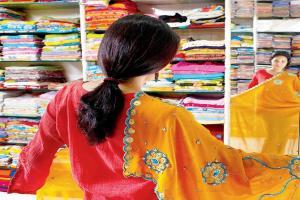In India, every state has its unique fabric, Kashmir to Kanyakumari every region has its own handloom techniques that are used to weave many unique fabrics

Representational picture
The Indian textiles industry is highly diversified ranging from the traditional handwoven sector to the capital intensive mill sector. The various categories of cloth produced on the basis of a process of production include the mill sector, power loom and handloom. A large variety of handlooms are used in different centres of the handloom industry from the oldest throw-shuttle loom to semiautomatic and automatic handlooms.
Ikkat from Orissa, Telangana and Gujarat
In India there are many kinds of Ikkats weaving, this differs from region to region. Few examples are Patans Patola, Pochampali, Telia Rumals, Sambalpuri etc. Ikat has also influenced weaving techniques in other countries like-, Indonesia, Japan and other South-East Asian countries for millennia. This form of textile production is also popular in Central and South American countries like Argentina, Bolivia and Mexico.
Patan Patola from Gujarat
Made in pure silk, Patola saris are the ultimate manifestation of the weaving prowess that the artisans of Gujrat have attained over several centuries. In the Patan town of Gujarat, this silk cloth with double Ikat patterns is brought to life as weavers work diligently for over five months to weave one Patola sari. The intricate weaving and dying techniques add to the authentic exoticism of th fabric.
Bandhani or tie and dye from Gujarat
Tie and dye or bandhani is a derivative of the Sanskrit word 'bandh' which means to tie and is one of the most popular textile arts of India. Considering they come from one of the most culturally rich states of Gujarat and Rajasthan, bandhani in its full glory is a burst of vibrant colours and glasswork.
Kalamkari from Andhra Pradesh
One of the most prominent features of Andhra Pradesh, Kalamkari is a kind of hand-painted or
block-printed textile art that dates back to the Indus Valley Civilisation. With a history of 3000 years, Kalamkari is known to have evolved during the Mughal era and has managed to retain its grace till date.
Brocades from Uttar Pradesh
Banarasi saris are one of India's most precious textile art form and wearing one is like wearing a piece of art. The weavers of Varanasi are nothing short of artists themselves as they weave with fine gold and silver metallic threads to create exotic delicate brocades. This high-quality weaving procedure has not only managed to sustain itself through the years but has also bounced back into the limelight for its sheer gorgeousness and beauty.
Handlooms, traditional wear in India has lost its significance slowly with the advent of low cost and eye-catchy synthetic materials. However, with the idea of 'Make in India'; campaign, and Khadi India initiative, the Government is taking initiatives by training artisan and educating the customer as well to know more about the handloom industry. Even on digital platforms, facebook campaigns like Six yards and 365 days, a campaign which is focused on two things – creating the desired attention and demand for the handloom saree and its varieties, as well as inculcating some knowledge about the traditional sarees among the present generation.
Indian handloom products are exported among top ten countries including USA, UK, Germany, and France. The Indian government launched Handloom brands to ensure its rareness, flexibility of production, openness to innovations, adaptability. The market study on the Handlooms identified the need for exposure, availability, Handloom designer dresses and awareness campaigns on a large scale for its nourishment.
- Contributed by Sunita Budhiraja, Founder Chairperson-Six yards and 365 Days
Catch up on all the latest Crime, National, International and Hatke news here. Also download the new mid-day Android and iOS apps to get latest updates
 Subscribe today by clicking the link and stay updated with the latest news!" Click here!
Subscribe today by clicking the link and stay updated with the latest news!" Click here!







_d.png)



